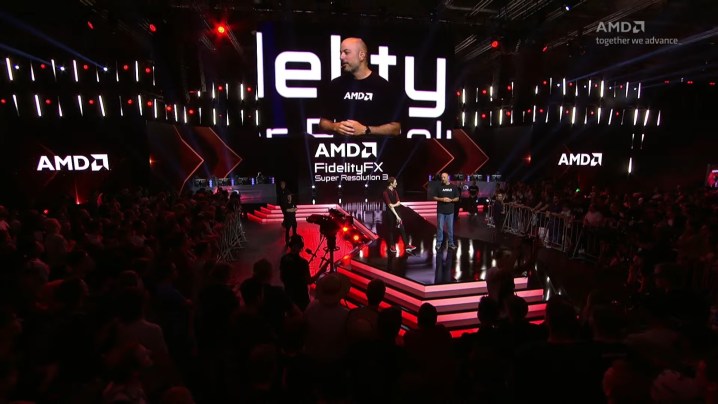
AMD’s FidelityFX Super Resolution 3 is available after nearly a year of waiting. The company announced the feature around November of last year, in a swift response to Nvidia’s, at the time, new Deep Learning Super Sampling 3 (DLSS 3). AMD’s pitch was simple. The company was going to deliver the same performance-multiplying feature that generates frames instead of rendering them, and it would work with any graphics card.
Now it’s here, and on paper, FSR 3 does exactly what AMD claimed. It’s clear AMD has a lot more work to do to make FSR 3 work properly, though. And after almost a year of waiting for the feature to arrive, it’s hard betting on promises for what FSR 3 could be in the future.
Where are the games?

There are so many great games for FSR 3 to debut in. AMD launched the feature in two games that were released this year: Forspoken and Immortals of Aveum. Both launched to a critical and commercial “meh” from the gaming community. Forspoken saw some attention at launch, in an otherwise dull time of the year, while Immortals of Aveum never reached above a peak player count of 1,000 on Steam.
Regardless of what you think of these games, they are not good candidates to launch some new, game-changing tech. Contrast that with DLSS 3.5 with Ray Reconstruction, which not only launched in Cyberpunk 2077 but alongside the game’s hotly anticipated 2.0 update. That’s how you debut a feature that gamers will get excited about.
Nvidia certainly has a dominant position in the GPU market, so it’s able to do things like timing the release of a new feature alongside a major game expansion. AMD, being far from the market leader, may not have that same amount of sway with developers. Regardless, AMD has put its stamp on some of the biggest game releases this year, all of which lack FSR 3.
AMD’s badge shows up in Resident Evil 4, Star Wars Jedi: Survivor, The Last of Us Part One, and most recently, Lies of P. Easily the biggest miss is Starfield, especially after AMD hyped up being the “PC exclusive partner” for the game. All of these games are absent from AMD’s list of upcoming FSR 3 games, too. The biggest title on the list is Cyberpunk 2077, but we still don’t know when FSR 3 will arrive in that game.
I have no doubt that FSR 3 will start showing up in more games throughout the rest of the year and into the next. That’s how these rollouts work. Launching FSR 3 with Forspoken and Immortals of Aveum isn’t AMD putting its best foot forward, though, especially with heavy hitters like Starfield and Star Wars Jedi: Survivor sitting on the back burner.
The compromise

The compromise for FSR 3’s lackluster support at launch seems to be AMD Fluid Motion Frames. This is not FSR 3 (at least not in name). Fluid Motion Frames is a driver-level feature available to RX 7000 and RX 6000 graphics cards that adds frame interpolation to DirectX 11 and DirectX 12 games. Both Fluid Motion Frames and FSR 3 offer frame interpolation, but FSR 3 is built into games while Fluid Motion Frames happens at the driver level.
That is a very important distinction. FSR 3, built into the game engine, is part of the rendering process. Fluid Motion Frames sits on top through the driver. FSR 3 can access information in the game engine, such as motion vectors and overlays, to present a cleaner final image. Fluid Motion Frames can’t.
AMD has made it clear that Fluid Motion Frames is still in its early days. It’s only available through a preview (beta) driver and with some strict stipulations. It makes sense that AMD took this approach because Fluid Motion Frames needs a lot of work.
For starters, it doesn’t always work. I’d suggest watching the breakdown from Daniel Owens below for an in-depth look in Cyberpunk 2077. Essentially, Fluid Motion Frames compares two sequential frames and uses them to guess what a frame in between would look like. It just doesn’t always work. As you can see in the breakdown, Fluid Motion Frames will give up if there’s too large of a difference between two frames and shut itself off temporarily. This is, according to AMD’s most recent patch notes, part of the design.
If you’re walking in a straight line or moving around slowly, you’ll see the smoothness boost Fluid Motion Frames boasts. If you’re in any sort of fast motion, where you want extra smoothness the most, the feature does essentially nothing. I’d argue it leads to a worse gameplay experience, too, as you’re jumping between a very high and relatively low frame rate whenever you’re in motion. A locked 60 frames per second (fps) looks and feels better than a frame rate constantly jumping up to 120 fps and down to 60 fps.
There are other problems that AMD didn’t draw attention to when it announced Fluid Motion Frames, too. For instance, Fluid Motion Frames will still attempt to interpolate frames, even when you’re in menus, leading to fine text and menu selection fields spinning out into a mess of artifacts. The dealbreaker for me is the base frame rate requirements, though.
AMD says you should have a base frame rate of at least 55 fps for a 1080p display, and at least 70 fps for a 1440p display for Fluid Motion Frames to work properly. What happens if you drop below that? Below, you can see Hogwarts Legacy at 4K with ray tracing turned on. Fluid Motion Frames causes this low frame rate to fall apart into a smearing mess that looks like you’re playing the game in slow motion. This video is fed through Twitter’s atrocious compression, but that’s doing the gameplay experience a favor here if anything.
This is outside of what AMD recommends for the tech, but it’s a good demonstration of the limitations of Fluid Motion Frames. It functions as a way to boost already high frame rates, and in a way that isn’t at all consistent. It’s particularly disappointing because this feature is something you can’t find with an Nvidia graphics card, and it would be one of the reasons to just ship to a GPU like AMD’s RX 7800 XT.
As with FSR 3, I’m sure AMD will continue to iterate on Fluid Motion Frames. This is still in a preview state for now, so some issues are to be expected. That’s my main problem with FSR 3 and Fluid Motion Frames, though. We’ve waited long enough.
Hurry up and wait

AMD’s rollout of FSR 3 reminds me of how Intel handled its first-gen Arc GPUs: the A750 and A770. They were announced prematurely, leading to a wave of speculation, rumors of cancellation, and a build-up of lofty expectations. When the GPUs finally arrived, it was clear Intel still had a lot of work to do on its drivers, which is why we’ve so commonly seen stories of Intel delivering double the performance in certain games with a driver update.
The accelerated announcement led to products that arrived in a half-finished state. FSR 3 feels similar. AMD announced the feature alongside its RX 7900 XTX and RX 7900 XT, setting up a narrative that FSR 3 would be a key feature of this next generation. Nearly a year on, we have FSR 3, but it’s nothing close to a key feature for AMD’s current generation.
We will see FSR 3 in more games, and I’m hopeful Fluid Motion Frames will mature into something that’s useful for AMD users. That’s what we’ve seen in the past with some of AMD’s other software features. Even now, though, far separated from the original announcement, FSR 3 still feels like a promise more than a feature.
There’s a lot of potential here for FSR 3. I’ve been forward about the fact that Nvidia is increasingly selling DLSS over the raw power of its GPUs, and AMD could do something similar with FSR 3. That requires careful execution with game support and features that make sense for a wide swath of gamers. Currently, FSR 3 and Fluid Motion Frames don’t deliver on those fronts.
I’m hopeful FSR 3 and Fluid Motion Frames will get better. But my excitement for the features that started in November of last year has all but disappeared.
Editors’ Recommendations
Services Marketplace – Listings, Bookings & Reviews